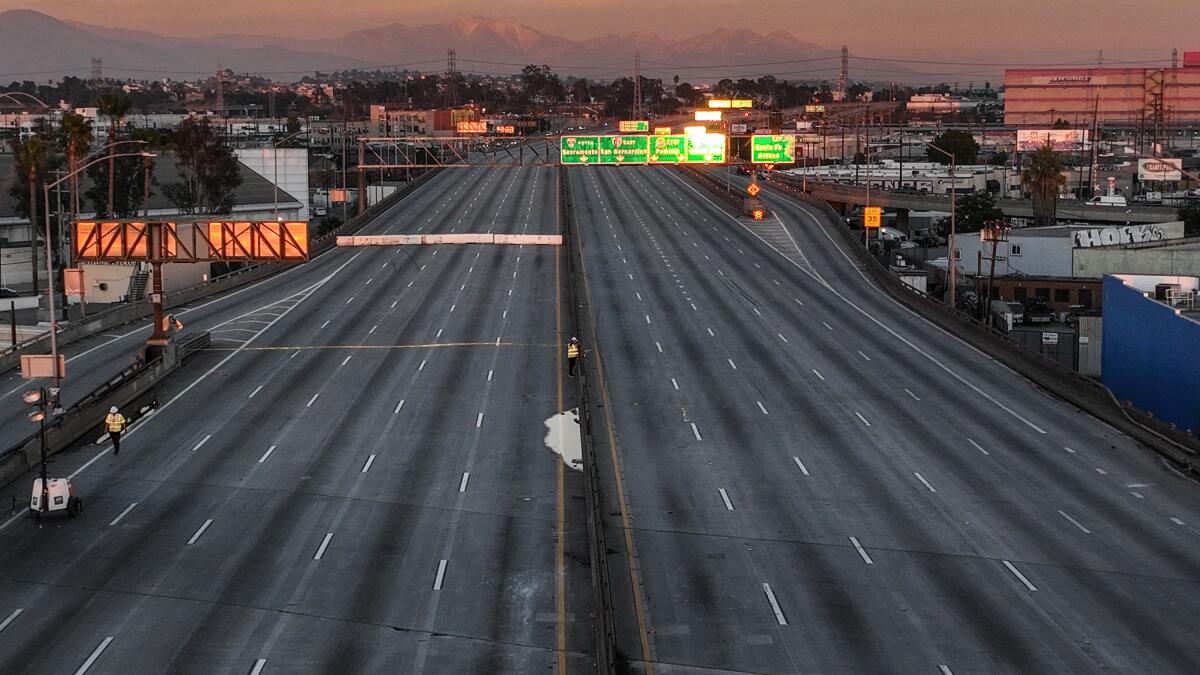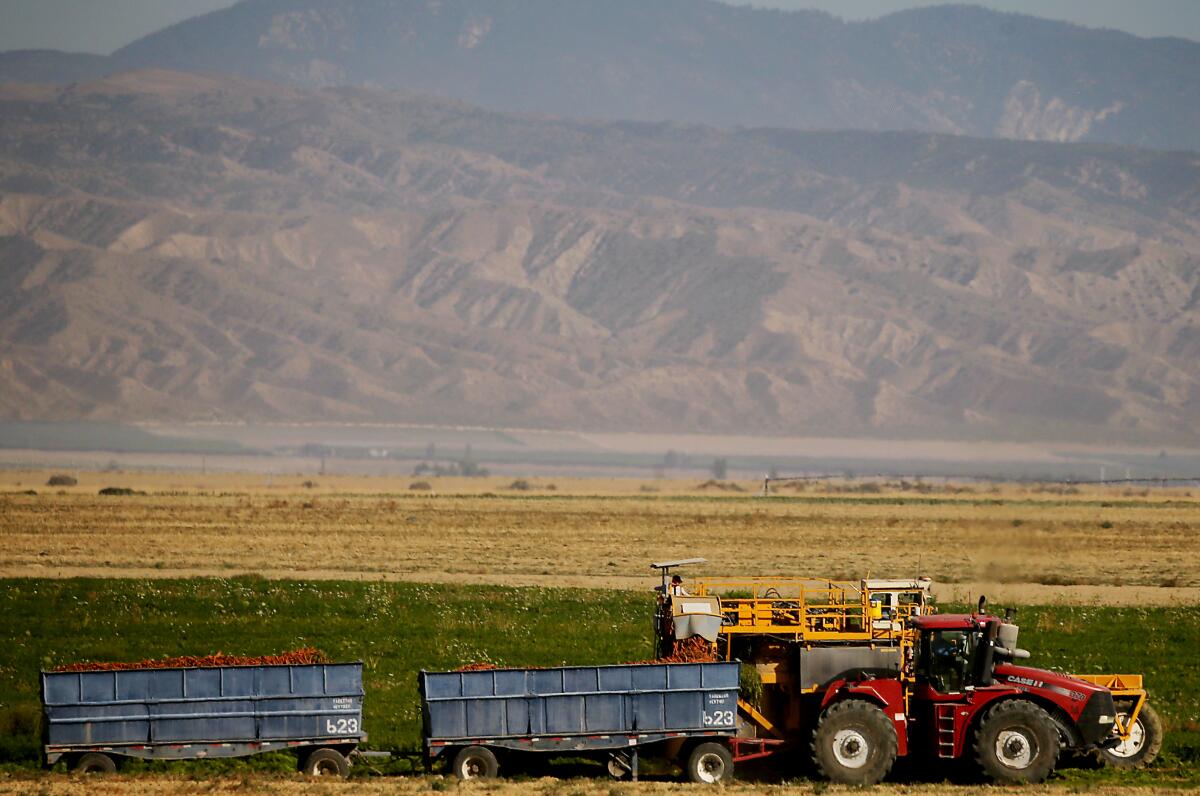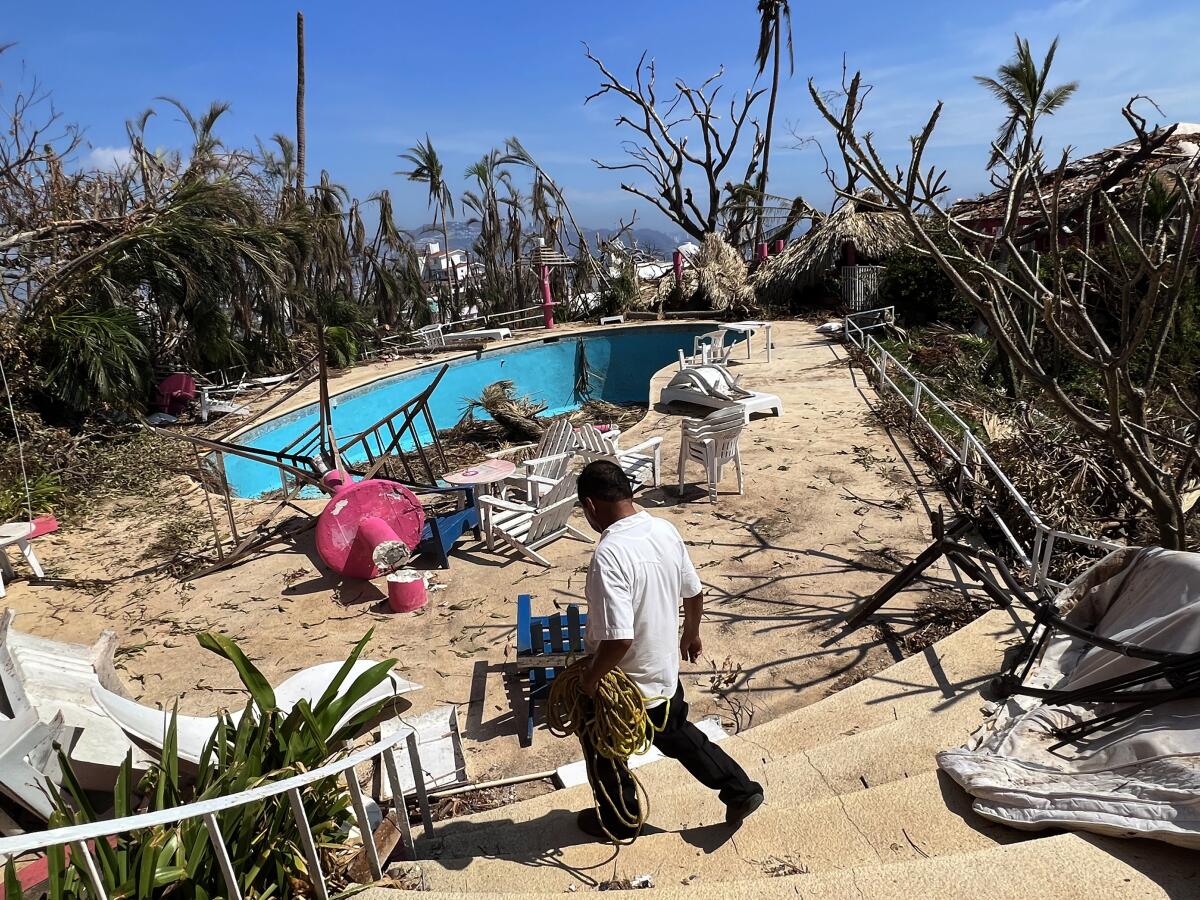What the 10 Freeway closure reveals about our reliance on an ‘overused’ system

- Share via
Good morning. It’s Tuesday, Nov. 14. Here’s what you need to know to start your day.
- How much trouble can closing part of the 10 Freeway cause?
- Rain is coming to Southern California. About 1 to 3 inches of it.
- Take a look inside Disneyland’s reopened Adventureland Treehouse.
- And here’s today’s e-newspaper
Sign up for Essential California
The most important California stories and recommendations in your inbox every morning.
You may occasionally receive promotional content from the Los Angeles Times.
How much trouble can closing one freeway (segment) cause?
The unavailability of a couple miles of roadway is big news in Los Angeles this week.
Early Saturday morning, a fire exploded below an overpass of the 10 Freeway in downtown Los Angeles, damaging the structure and leading officials to close about two miles of the heavily trafficked route indefinitely. As of Monday evening, inspectors were still determining if the damaged section can be repaired or if it will have to be torn down and replaced.
Later Saturday, Gov. Gavin Newsom declared a state of emergency to help speed cleanup and repair of the freeway, vowing a 24/7 response. Mayor Karen Bass said she’s been in touch with Biden administration officials about additional resources to get the freeway back open.
Speaking to media from behind a lectern with a “Fix the 10” logo at a news conference Monday, Newsom said officials are exploring the repair and replace options in tandem and will make their decision based on “safety, not just speed” of reopening the segment.
State Fire Marshal Daniel Berlant said CalFire investigators were able to “confidently determine that the fire was caused by arson” and are working to identify the person or persons responsible.
The fire started on leased land under the freeway that was being used as storage yards. It’s a common practice in California and across the nation for state and local agencies to lease out space under freeways to third parties. In this case, the lessee was a Calabasascompany called Apex Development Inc., according to Newsom.
But the company had been out of compliance and hadn’t paid their lease for some time, the governor said, leading the city to take legal action before the fire. According to Newsom, Apex had also been illegally subleasing the land to several other tenants without authorization from state and federal agencies.
The closure has disrupted travel for hundreds of thousands of commuters who drive through the corridor, which has connections to the 110 Freeway to the west and links to the 5, 101 and 60 freeways to the east.
For more on the affected area and detour routes and alternative commuting options, check out this guide from my colleague Nathan Solis.
How did things look on the first weekday morning of the closure? Eric Menjivar, a spokesperson for Caltrans, said early morning traffic — starting about 5 a.m. — was actually lighter than normal. But by 7 a.m., traffic increased above typical levels on nearby freeways.
Repair or rethink?
The swift reaction from state and local leaders stood out to some mobility advocates, who have long called on elected officials to show a similar sense of urgency to expand and repair train service, fix bike paths and boost funding for street safety upgrades and efforts aimed at reducing driving to help reach climate goals.
For Michael Schneider, founder of the nonprofit Streets for All, the response to the 10 Freeway closure shows “how quickly government can move when it wants to.” He also wonders about the costs (still TBD) of repairing or replacing the segment.
“It seems like money is no object when it comes to car infrastructure,” Schneider said. “Yes, we should repair infrastructure that breaks, but it’s also an opportunity to zoom out and rethink … our choices. Does it make sense to just automatically rebuild a freeway?”
He hoped leaders would have taken a beat to consider if a better version of the roadway could be built instead of doubling down on “decisions made by our grandparents’ generation.”
“No one’s asking these questions,” he said. “Everyone’s just, ‘Fix it, fix it, fix it!’ ”
A numbers game
As Michael Manville, professor and chair of the Department of Urban Planning at the UCLA Luskin School of Public Affairs, explained, it just comes down to the numbers. Caltrans officials say about 300,000 vehicles on average move through the affected stretch of the 10 Freeway each day.
“The way our freeways were built, they are a rather small minority of our roads system that carries a hugely disproportionate share of our traffic,” Manville said. “When there are big interruptions to them, they really do have effects that reverberate around the region.”
Manville said there are two key costs associated with traffic: congestion costs, “which is you sitting in the traffic,” and scheduling costs, “the things you do to avoid sitting in the traffic.”
“This will probably increase people’s scheduling costs, even if we don’t see huge increases in actual delay,” Manville said.
Some commuters may be able to adjust their work schedules, work remotely or alter their travel patterns to ease the traffic pain. But many will not be able to do that. Exactly how that plays out in the coming days, weeks and possibly longer remains unclear.
“Angelenos can find a way to get around things,” Menjivar said. “They’re very savvy when it comes to getting from point A to point B.”
Short-term hiccup vs. long-term challenge
While it’s not clear as of Monday evening how long it will take to reopen the 10, officials at L.A. Metro have been working to court affected commuters. So far that had not translated to more frequent service, though Metrolink is now running more train service on its San Bernardino line.
But Manville is not confident the closure will have much impact on people’s commute habits long-term. The deeper problem, he said, is that neither our freeway system nor our public transit system works as well as they could and should.
“Most people’s experience with the freeway at rush hour is already pretty miserable — and that does not drive a lot of people to public transportation, which says something about our public transportation,” he said.
“I think most people in Los Angeles understand that we are over-reliant on a bunch of roads that don’t perform well because they’re overused.”
Here’s more of our coverage on the 10 freeway closure:
- A freeway closure and snarled traffic pose a fresh political test for Mayor Bass.
- Damage to the 10 Freeway was not as severe as expected, an engineer says, but more tests are needed.
Today’s top stories
Extreme weather and climate change
- Two weeks after Hurricane Otis slammed Acapulco, smashed buildings, overturned boats and broken lives lie in its wake.
- Heat waves, wildfires and other extreme events are hitting California and the Southwest hard. Plus five more takeaways from the latest U.S. climate report.
- Expect 1 to 3 inches of rain to fall on Southern California over the next four days (but no intense storms or flooding, forecasters say).
Tustin hangar fire
- The historic Tustin hangar reignited over the weekend and continued to burn Monday.
- The hangar first went up in flames last week, releasing asbestos and other toxic substances into the air.
Celebrities
- Keke Palmer’s ex-boyfriend, Darius Jackson, wiped his Instagram amid abuse allegations.
- Kel Mitchell discussed the health scare that landed him in the hospital last week: ‘The whole right side of my arm and leg was numb.’
- What Billie Eilish learned from her own ‘Barbie’ song, ‘What Was I Made For?’
War in the Middle East
- An Israeli settler in the West Bank whose son was taken hostage by Hamas said he would rather his son be executed by his captors than for his nation to cede any territory or give in to any demands by Hamas.
- Despite Israel’s relentless military campaign in Gaza, Hezbollah has unleashed little of its boasted firepower on Israel’s northern flank. Many wonder what would push the group to all-out war.
The SAG-AFTRA contract
- SAG-AFTRA has released an 18-page summary of its strike-ending tentative agreement with the major Hollywood studios.
- A 7% wage increase, new AI protections and other highlights from the SAG-AFTRA contract.
More big stories
- Justice Clarence Thomas’ luxury travels put pressure on the court to adopt new ethics rules. But the new code looks a lot like the existing one for federal judges.
- The son of a Hollywood exec who tried to get day laborers to move body parts has been charged with murder of his wife and in-laws.
- Survivors of the Monterey Park shooting who weren’t injured asked to be included in the GoFundMe donation pool. The nonprofits behind it said no.
- Enrollment of international students at U.S. colleges and universities has rebounded from a pandemic plunge. And California is still the No. 1 destination.
- Harvard-Westlake’s plan for an athletic facility in Studio City has drawn heated opposition.
Get unlimited access to the Los Angeles Times. Subscribe here.
Commentary and opinions
- Sammy Roth: Want people to understand climate change? Pay the experts.
- LZ Granderson: Closing the wage gap for Black women is an investment, not charity.
- Jonah Goldberg: After a week of mostly bad reelection news, Biden has only one choice.
- Jackie Calmes: The shutdown looms, and Speaker Mike Johnson has nothing.
- Editorial: The rising tide of hate crimes can’t be ignored.
- George Skelton: It’s about time California built the Sites Reservoir.
- Opinion: What kind of seafood is morally ethical to eat?
Today’s great reads

In some Latin American drug cartels, women are the violent new overlords. In an excerpt from her book “Narcas,” veteran journalist Deborah Bonello uncovers some of the powerful women inside the macho world of Latin America’s brutal drug gangs.
Other great reads
- Want to save our cities? Look to San Francisco’s iconic survivor: the Ferry Building.
- How the all-female trio Conexión Divina went from meeting on the internet to the Latin Grammys in two years.
- How making music became an act of survival for Jon Batiste.
- Once on the fringes, lowrider owners and car clubs flexed their political muscle and helped pass a law to bring back cruise nights.
- How the JFK assassination changed TV news and the journalists who covered it 60 years ago.
- The 1994 earthquake broke the 10 Freeway. How L.A. rebuilt it in record time.
How can we make this newsletter more useful? Send comments to [email protected].
For your downtime

Going out
- 🥧🍖 Skipping the cooking doesn’t mean your dinner table has to stay empty on the biggest feasting holiday of the year. Here are the best L.A. restaurants for a Thanksgiving takeout feast.
- 🥟There’s a wonderful trend that’s been happening over the last couple of years: a proliferation of casual dumpling spots in and around Los Angeles.
- 🎭 Comedian Alex Edelman brings his acclaimed Broadway show, in which he muses on Jewish identity, empathy and how he came to hang out with a group of white nationalists, to the Mark Taper Forum.
- 🌲🏠 A look inside Disneyland’s reopened Adventureland Treehouse.
Staying in
- 📚 Six memoirs to put you in a Palestinian’s shoes.
- 📺 Fans of Edith Wharton hoping to find some sense of her in Apple TV+’s wayward adaption of her novel “The Buccaneers” may well be disappointed.
- 🧑🍳 Here’s a recipe for Sichuan chimichurri.
- ✏️ Get our free daily crossword puzzle, sudoku, word search and arcade games.
And finally ... a great photo
Show us your favorite place in California! Send us photos you have taken of spots in California that are special — natural or human-made — and tell us why they’re important to you.

Today’s great photo is from the Times’ Luis Sinco at a field near New Cuyama, Calif. In California’s Cuyama Valley, companies pump vast amounts of water to grow carrots. When companies sued residents over water, the community launched a boycott.
Have a great day, from the Essential California team
Ryan Fonseca, reporter
Kevinisha Walker, multiplatform editor
Laura Blasey, assistant editor
Karim Doumar, head of newsletters
Check our top stories, topics and the latest articles on latimes.com.
Sign up for Essential California
The most important California stories and recommendations in your inbox every morning.
You may occasionally receive promotional content from the Los Angeles Times.





